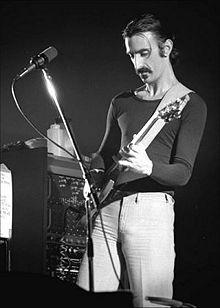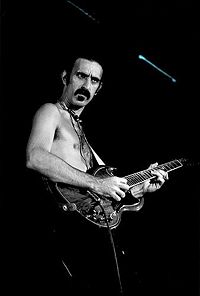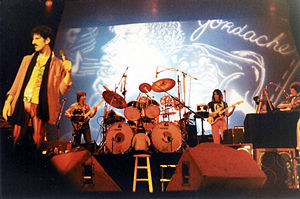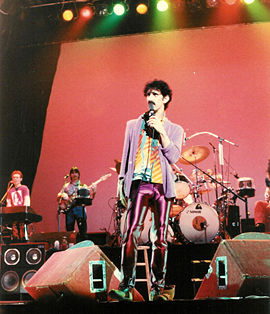Frank Zappa
| Frank Zappa | |
|---|---|
 Frank Zappa at a concert in Norway in 1977
| |
| Background information | |
| Birth name | Frank Vincent Zappa |
| Born | December 21 1940 Baltimore, Maryland |
| Died | December 4 1993 (aged 52) Los Angeles, California |
| Genre(s) | Rock, jazz, classical, experimental |
| Occupation(s) | Composer, Musician, Conductor, Producer |
| Instrument(s) | Vocals, guitar, bass guitar, keyboards, vibraphone, synclavier, drums |
| Years active | 1950s‚Äď1993 |
| Label(s) | Verve/MGM, Bizarre/Straight, DiscReet, Zappa Records, Barking Pumpkin Records, Rykodisc |
| Associated acts | The Mothers of Invention Captain Beefheart |
| Website | Zappa.com |
| Notable instrument(s) | |
| Gibson ES-5 Switchmaster Gibson SG Gibson Les Paul Fender Stratocaster Synclavier | |
Frank Vincent Zappa (December 21, 1940 ‚Äď December 4, 1993) was an American composer, musician, and film director. Until discovering his birth certificate as an adult, Zappa believed he had been christened "Francis," and he is credited as Francis on some of his early albums. His real name was "Frank," however, never "Francis."[1] In a career spanning more than 30 years, Zappa established himself as a prolific and highly distinctive composer, electric guitar player, and band leader. He worked in almost every musical genre and wrote music for rock bands, jazz ensembles, synthesizers, and symphony orchestra, as well as avant-garde works constructed from pre-recorded, synthesized, or sampled sources. In addition to his music recordings, he created feature-length and short films, music videos, and album covers.
Zappa's ability to coalesce eclectic and highly-varied musical styles and genres into a unified musical expression was a hallmark of his output. A thorough-going iconoclast, he directed his barbed wit not only against the Washington political establishment and the Hollywood music industry, but also toward the hippie and drug cultures, suburban "valley girls," and the insipid music of youth.
Zappa was posthumously inducted into the Rock and Roll Hall of Fame in 1995 and received a Grammy Lifetime Achievement Award in 1997. In 2005, his 1968 album with the Mothers of Invention, We're Only in It for the Money, was inducted into the United States National Recording Preservation Board's National Recording Registry. The same year, Rolling Stone magazine ranked him number 71 on its list of the 100 Greatest Artists of All Time.
Career summary and reputation
Although he only occasionally achieved commercial success, Zappa maintained a highly productive career that encompassed composing, recording, touring, producing, and merchandising his own and others' music. Zappa self-produced almost every one of the more than 60 albums he released with the Mothers of Invention and as a solo artist. He received multiple Grammy nominations and won the Grammy Award for Best Rock Instrumental Performance in 1988, for the album, Jazz from Hell.[2] Throughout his career, Zappa took a keen interest in the visual presentation of his work, designing some of his album covers and directing his own films and videos.
Politically, Zappa was a self-proclaimed "practical conservative," an avowed supporter of capitalism and independent business.[3] He was also a strident critic of mainstream education and organized religion. Zappa was a forthright and passionate advocate for freedom of speech and the abolition of censorship, and his work embodied his skeptical view of established political processes and structures. Although many assumed that he used drugs like many musicians of the time, Zappa strongly opposed recreational drug use. Indeed, he lost many fans in the late 60s by his sarcastic denigration of the hippie lifestyle and the Beatles.
Zappa was married to Kathryn J. "Kay" Sherman (1960‚Äď1964; no children), and then in 1967, to Adelaide Gail Sloatman, with whom he remained until his death in December 1993 of prostate cancer. They had four children: Moon Unit, Dweezil, Ahmet Emuukha Rodan, and Diva Thin Muffin Pigeen.
Biography
Early life and influences
Zappa was born in Baltimore, Maryland, on December 21, 1940, to Sicilian-born Francis Zappa, who was of Greek-Arab descent, and Rose Marie Colimore who was three quarters Italian and one quarter French. He was the oldest of four children‚ÄĒtwo brothers and a sister. During Zappa's childhood, the family often moved because his father, a chemist and mathematician, had various jobs in the U.S. defense industry. After a brief period in Florida in the mid-1940s, the family returned to Edgewood, Maryland.
As a child, Zappa was often sick, suffering from asthma, earaches and a sinus problem. In 1952, his family relocated again, mainly because of Zappa's asthma. They settled first in Monterey, California, where Zappa’s father taught metallurgy at the Naval Postgraduate School. Shortly thereafter, they moved to Claremont, then again to El Cajon before once again moving to San Diego. During this period, his parents bought a record player, an event initiating Zappa’s interest in music, and he soon started collecting records. Television also exerted a strong influence, as demonstrated by quotations from show themes and advertising jingles found in some of Zappa's later work.
The first records Zappa purchased were R&B singles, and he began building a large collection that he would keep for the rest of his life. He was particularly interested in the sounds of drums and percussion. He owned a snare drum at age 12 and started learning the rudiments of orchestral percussion.[4] Around the age of 13, Zappa began to become deeply engaged with modern classical music when he was around 13, especially the percussion works of Edgard Varèse. By 1955, the Zappa family moved to Lancaster, a small aerospace and farming town in Antelope Valley of the Mojave Desert, close to Edwards Air Force Base, Los Angeles, and the San Gabriel Mountains.
Zappa's heterogeneous ethnic background and the diverse cultural and social mix that existed in and around greater Los Angeles at the time were also crucial in situating Zappa as a practitioner and fan of "outsider art." His mother gave him considerable encouragement in his musical interests. Though she disliked Varèse's music, she was indulgent enough to award Zappa a long distance call to the composer as a fifteenth birthday present.
In 1956, Zappa met Don Van Vliet (best known by his stage name "Captain Beefheart") while taking classes at Antelope Valley High School and playing drums in a local band, the Blackouts. In 1957 Zappa was given his first guitar. Among his early influences were Johnny "Guitar" Watson, Howlin' Wolf, and Clarence "Gatemouth" Brown. Zappa developed an eclectic, innovative, and personal guitar style and eventually became one of the most highly regarded electric guitarists of his time.[5]
Zappa's interest in composing and arranging burgeoned in his later high school years where he started seriously dreaming of becoming a composer. By his final year of high school, he was writing, arranging and conducting avant-garde performance pieces for the school orchestra. He graduated from Antelope Valley High School in 1958, and he would later acknowledge two of his music teachers on the sleeve of the 1966 album, Freak Out!
He left community college after one semester, and maintained thereafter a disdain for formal education, taking his children out of school at age 15 and refusing to pay for their college.
1960s
Zappa attempted to earn a living as a musician and composer, playing a variety of night-club gigs, some with a new version of the Blackouts. More important financially, however, were Zappa's earliest professional recordings: Two soundtracks for the low-budget films The World's Greatest Sinner (1962) and Run Home Slow (1965).
In 1965, joined Zappa a local R&B band, the Soul Giants, as a guitarist. Zappa soon he assumed leadership of the band, convincing its other members to play his original music so as to increase the chances of getting a record contract.[6] The band was renamed "The Mothers" on Mothers Day. The group increased their bookings after beginning an association with manager Herb Cohen, and they gradually began to gain attention on the burgeoning Los Angeles underground scene. In early 1966, The Mothers were spotted by leading record producer Tom Wilson, when playing ‚ÄúTrouble Every Day,‚ÄĚ a song about the Watts Riots. Wilson had earned acclaim as the producer for Bob Dylan and Simon & Garfunkel, and was also notable as one of the few African-Americans working as a major label pop producer at this time.
Wilson signed The Mothers to the Verve division of MGM, which had built up a strong reputation for its modern jazz recordings in the 1940s and 1950s, but was then attempting to diversify into [[pop music|pop| and rock, with an "artistic" or "experimental" bent. Verve insisted that the band officially re-title themselves "The Mothers of Invention" because "Mother" was short for "motherf-cker."
With Wilson credited as producer, The Mothers of Invention recorded the groundbreaking double-album Freak Out! (1966). It mixed R&B, doo-wop, and experimental sound collages that captured the "freak" subculture of Los Angeles at that time. The album immediately established Zappa as a radical new voice in rock music, providing an antidote to the “relentless consumer culture of America."[7] The sound was raw, but the lyrics and arrangements were both sophisticated and highly original.
Wilson also produced the follow-up album, Absolutely Free (1967). It focused more on songs that defined Zappa’s compositional style of introducing abrupt rhythmical changes into songs that were built from of complex musical elements. The album's music sophistication dampened its commercial success but established Zappa as a serious composer rather than the leader of what many believed at the time to be a musically complex acid rock band.
The Mothers of Invention played in New York in late 1966, and were offered a contract at the Garrick Theatre in London during Easter 1967. This also proved successful, and the booking came to last half a year. Returning to New York, the Mothers of Invention recorded the album widely regarded as the peak of the group's late-60s work, We're Only in It for the Money (released 1968). It was produced by Zappa, with Wilson credited as executive producer. From then on, Zappa would produce all albums released by the Mothers of Invention or himself. We're Only in It for the Money featured some of the most creative audio editing and production yet heard in pop music. The songs, however, alienated some fans as they ruthlessly satirized the hippie and flower power phenomena, with the cover photo parodying that of The Beatles' Sgt Pepper's Lonely Hearts Club Band.
While in New York, Zappa increasingly used tape editing as a compositional tool. A prime example is found on the double album Uncle Meat (1969), where the track "King Kong" is edited from various studio and live performances. Zappa had begun regularly recording concerts, and because of his insistence on precise tuning and timing in concert, Zappa was able to augment his studio productions with excerpts from live shows, and vice versa.
Zappa and the Mothers of Invention returned to Los Angeles in the summer of 1968. Although they had many avid fans and the group's musicianship was unrivaled, crowds at their live concerts often reported Zappa as disdainful of his young audiences, and thus the early popularity of the Mothers of Invention began to wane. In 1969, the Mothers had nine members, and Zappa was supporting the group himself from his publishing royalties, whether they played or not. In late 1969, Zappa broke up the band due to financial strain. Although this caused some bitterness among band members, several would return to Zappa in years to come. Remaining recordings with the band from this period were collected on Weasels Ripped My Flesh and Burnt Weeny Sandwich (both 1970).
After he disbanded the Mothers of Invention, Zappa released the acclaimed solo album Hot Rats (1969). It features, for the first time on record, Zappa playing extended guitar solos. It also contains one of Zappa‚Äôs most enduring compositions, ‚ÄúPeaches En Regalia,‚ÄĚ which would reappear several times on future recordings.
1970s
Zappa kept composing music for symphony orchestras while playing and recording with the Mothers of Invention. He made contact with conductor Zubin Mehta and a concert was arranged in May 1970, where Mehta conducted the Los Angeles Philharmonic amended with a rock band.
Zappa's next solo album was Chunga's Revenge (1970), which was followed by the double-album soundtrack to the movie 200 Motels (1971), featuring the Mothers, The Royal Philharmonic Orchestra, and, among others, Ringo Starr, Theodore Bikel, and Keith Moon. The film, co-directed by Zappa and Tony Palmer, was shot in a week on a large sound stage outside of London.
Flo and Eddie
After The Turtles dissolved, Howard Kaylan and Mark Volman, also known as "Flo and Eddie," joined the Mothers of Invention as "Phlorescent Leech & Eddie." Due to contractual restrictions made early in their career, Mark and Howard were prevented from using the name "The Turtles," as well as their own names in a musical context.
While with The Mothers, they appeared on
Chunga's Revenge
200 Motels (soundtrack)
Fillmore East-June 1971
Just Another Band From L.A. …as well as appearing in the film 200 Motels.
Over-Nite Sensation
In 1971-72 Zappa released two strongly jazz-oriented solo LPs, Waka/Jawaka and The Grand Wazoo, which were recorded during the forced layoff from concert touring, using floating line-ups of session players and Mothers alumni. Among other albums from the period is the ironically titled Over-Nite Sensation (1973), Zappa's first commercial success which contained several future concert favorites. It is by some considered one of Zappa’s best albums. It was followed by his greatest commercial success, Apostrophe ('), which contained his only single to make the pop charts, "Don't Eat the Yellow Snow." The albums Roxy & Elsewhere (1974) and One Size Fits All (1975) feature ever-changing versions of a bands still called the Mothers, and were notable for the tight renditions of the highly difficult jazz-fusion songs, demonstrated by such pieces as "Inca Roads," "Echidna's Arf (Of You)," or "Be-Bop Tango (Of the Old Jazzmen's Church)." A live recording from 1974, You Can't Do That on Stage Anymore, Vol. 2 (1988), captures the instrumental excellence of the 1973-75 band. Zappa would also release Bongo Fury (1975), which featured live recordings from a tour the same year that reunited him with Captain Beefheart for a brief period.
1980s
After spending most of 1980 on the road, Zappa released Tinsel Town Rebellion in 1981. It was the first release on Barking Pumpkin Records. The album is a mixture of complicated instrumentals and Zappa's use of sprechstimme (speaking song or voice)‚ÄĒa compositional technique utilized by such composers as Arnold Schoenberg and Alban Berg‚ÄĒshowcasing some of the most accomplished bands Zappa ever had. The political and sociological satire in songs like the title track and ‚ÄúThe Blue Light‚ÄĚ have been described as ‚Äúhilarious critique of the willingness of the American people to believe anything.‚ÄĚ[8] The album is also notable for the presence of guitar virtuoso Steve Vai, who joined Zappa's touring band in the Fall of 1980.
The same year the double album You Are What You Is was released. Most of the album was recorded in Zappa's brand new Utility Muffin Research Kitchen (UMRK) studios, which were located at his house, thereby giving him complete freedom to work. The album included one complex instrumental, "Theme from the 3rd Movement of Sinister Footwear," but focused mainly on rock songs with Zappa's sardonic social commentary satirical lyrics targeted against teenagers, the media, and religious and political hypocrisy. "Dumb All Over," is a tirade on religion, as is "Heavenly Bank Account," wherein Zappa rails against TV evangelists such as Jerry Falwell and Pat Robertson for their purported influence on the U.S. administration as well as their usage of religion as a means of raising money. 1981 also saw the release of three instrumental albums Shut Up 'N Play Yer Guitar, Shut Up 'N Play Yer Guitar Some More, and The Return of the Son of Shut Up 'N Play Yer Guitar, which were initially sold via mail order by Zappa himself, but were later released commercially through CBS label due to popular demand. The albums focused exclusively on Frank Zappa as a guitar soloist, and the tracks are predominantly live recordings from 1979-80, and highlight Zappa's improvisational skills with ‚Äúbeautiful recordings from the backing group as well.‚ÄĚ The albums were subsequently released as a 3-album box set, and were in 1988 followed by the album Guitar focusing on recordings from 1981-82 and 1984. A third guitar-only album, Trance-Fusion, completed by Zappa shortly before his death, featuring solos recorded between 1979 and 1988 (with an emphasis on 1988) was released in 2006.
In May 1982, Zappa released Ship Arriving Too Late to Save a Drowning Witch, which featured his biggest selling single ever, the Grammy nominated "Valley Girl" (topping out at number 32 on the Billboard charts. In her improvised "lyrics" to the song, Zappa's daughter Moon Unit satirized the vapid speech of teenage girls from the San Fernando Valley, which popularized many "Valspeak" expressions such as "gag me with a spoon" and "barf out."
The year 1983 saw the release of two different projects, beginning with The Man From Utopia, a rock-oriented work. The album itself is eclectic, featuring the vocal-led "Dangerous Kitchen" and "The Jazz Discharge Party Hats," both continuations of the ‚ÄúSprechstimme‚ÄĚ excursions on Tinseltown Rebellion. The second album, London Symphony Orchestra, Vol. 1 contained orchestral Zappa compositions conducted by Kent Nagano and performed by the London Symphony Orchestra. A second record of these sessions, London Symphony Orchestra, Vol. 2, was released in 1987.
For the remainder of his career, much of Zappa's work was affected by use of the synclavier as a compositional and performance tool. One could program the synclavier to play almost anything conceivable to perfection. ‚ÄúWith the Synclavier, any group of imaginary instruments can be invited to play the most difficult passages ‚Ķ with one-millisecond actually‚ÄĒevery time,‚ÄĚ even though it essentially did away with the need for musicians.[9] In 1984, he released four albums. Boulez Conducts Zappa: The Perfect Stranger, which juxtaposed orchestral works was commissioned and conducted by world-renowned conductor Pierre Boulez and performed by his Ensemble InterContemporain, as well as premiere synclavier pieces.
The album Thing-Fish was an ambitious three-record set in the style of a Broadway play dealing with a dystopian "what-if" scenario involving feminism, homosexuality, manufacturing and distribution of the AIDS virus, and a eugenics program conducted by the United States government.[10] New vocals were combined with previously released tracks and new synclavier music, and therefore "the work is an extraordinary example of bricolage" in Zappa's production.
On September 19, 1985, Zappa testified before the U.S. Senate Commerce, Technology, and Transportation committee, attacking the Parents Music Resource Center or PMRC, a music censorship organization, founded by then-Senator Al Gore's wife Tipper Gore. Zappa put some excerpts from the PMRC hearings to synclavier-music in his composition, "Porn Wars" from the 1985 album, Frank Zappa Meets the Mothers of Prevention.
The album Jazz From Hell, released in 1986, earned Zappa his first Grammy Award in 1988, for Best Rock Instrumental Performance. Except for one live guitar solo, the album exclusively featured compositions brought to life by the synclavier.
Around 1986, Zappa undertook a comprehensive re-release program of his earlier recordings.[11] He personally oversaw the remastering of all his 1960s, 1970s, and early 1980s albums for the new compact disc medium. Certain aspects of these re-issues were, however, criticized by some fans as being unfaithful to the original recordings.[12]
1990s
In early 1990, Zappa visited Czechoslovakia at the request of President Václav Havel, a lifelong fan, and was asked by Havel to serve as consultant for the government on trade, cultural matters and tourism. Zappa enthusiastically agreed and began meeting with corporate officials interested in investing in Czechoslovakia. Within a few weeks, however, the U.S. administration put pressure on the Czech government to withdraw the appointment. Havel made Zappa an unofficial cultural attaché instead.[13]
Zappa's political work would soon come to a halt, however. In 1991, he was diagnosed with terminal prostate cancer. After his diagnosis, Zappa devoted most of his energy to modern orchestral and synclavier works.
In 1992, he was approached by the German chamber ensemble Ensemble Modern who was interested in playing his music. Although ill, Zappa invited them to Los Angeles for rehearsals of new compositions as well as new arrangements of older material. In addition to being satisfied with the ensemble’s performances of his music, Zappa also got along well with the musicians, and concerts in Germany and Austria were set up for the fall. In September 1992, the concerts went ahead as scheduled, but Zappa could only appear at two of them in Frankfurt due to his illness. They would be his last public appearances in a musical function. Recordings from the concerts appeared on The Yellow Shark (1993), Zappa’s last release when alive, and some material from studio rehearsals appeared on the posthumous Everything Is Healing Nicely (1999). In 1993, prior to his death, he completed Civilization, Phaze III, a major synclavier work he had begun in the 1980s.
Frank Zappa died on December 4, 1993, age 52, from prostate cancer. He was interred in an unmarked grave at the Westwood Village Memorial Park Cemetery in Westwood, California.
Legacy
In the annals of American popular music, Frank Zappa will be remembered for his uncompromising social attitudes and excellent musicianship. In many ways he was a pioneer as his musical temperament yielded an amazing body of work that defied just about every convention of the era in which he lived and worked. The melange of musical styles (pop, jazz, R & B, electronica, experimental avant-garde) that comprised his musical palette, made it difficult to stereotype his music. Though this severely limited any broad popular appeal and any resulting commercial success, he nonetheless became an iconic figure admired by many. The polyglot nature of his music could be characterized as being quintessentially "American" due its diversity and in his willingness to accept any style or influence into his compositional universe.
Notes
- ‚ÜĎ Zappa, 1989.
- ‚ÜĎ Rolling Stone, "The Immortals" in Rolling Stone, issue 972.
- ‚ÜĎ Dan Ouellette, Interview with Frank Zappa, Pulse! Magazine. Retrieved October 17, 2008.
- ‚ÜĎ Zappa (1989), 29.
- ‚ÜĎ Rolling Stone, The 100 Greatest Guitarists of All Time.
- ‚ÜĎ Zappa (1989), 65-66.
- ‚ÜĎ Miles (2004), 115.
- ‚ÜĎ Lowe (2006), 165.
- ‚ÜĎ Miles (2004), 319.
- ‚ÜĎ British Theater Guide, Thing-Fish‚ÄĒThe Return of Frank Zappa. Retrieved October 17, 2008.
- ‚ÜĎ Miles (2004), 340.
- ‚ÜĎ Luk Pac, The Frank Zappa Album Versions Guide. Retrieved October 17, 2008.
- ‚ÜĎ Miles (2004), 357-361.
ReferencesISBN links support NWE through referral fees
- James, Billy. Necessity Is‚ÄĒ: The Early Years of Frank Zappa & the Mothers of Invention. London: SAF, 2001. ISBN 978-0946719143.
- Lowe, Kelly Fisher. The Words and Music of Frank Zappa. The Praeger singer-songwriter collection. Westport, Conn: Praeger, 2006. ASIN B01K3L4PUQ
- Miles, Barry. Frank Zappa: The Biography. New York, NY: Grove Press, 2004. ISBN 978-0802142153.
- Zappa, Frank, and Peter Occhiogrosso. The Real Frank Zappa Book. New York: Poseidon Press, 1989. ISBN 978-0671638702.
External links
All links retrieved April 9, 2024.
- The Official Frank Zappa Site www.zappa.com
- Frank Zappa at the Internet Movie Database www.imdb.com
Credits
New World Encyclopedia writers and editors rewrote and completed the Wikipedia article in accordance with New World Encyclopedia standards. This article abides by terms of the Creative Commons CC-by-sa 3.0 License (CC-by-sa), which may be used and disseminated with proper attribution. Credit is due under the terms of this license that can reference both the New World Encyclopedia contributors and the selfless volunteer contributors of the Wikimedia Foundation. To cite this article click here for a list of acceptable citing formats.The history of earlier contributions by wikipedians is accessible to researchers here:
The history of this article since it was imported to New World Encyclopedia:
Note: Some restrictions may apply to use of individual images which are separately licensed.


